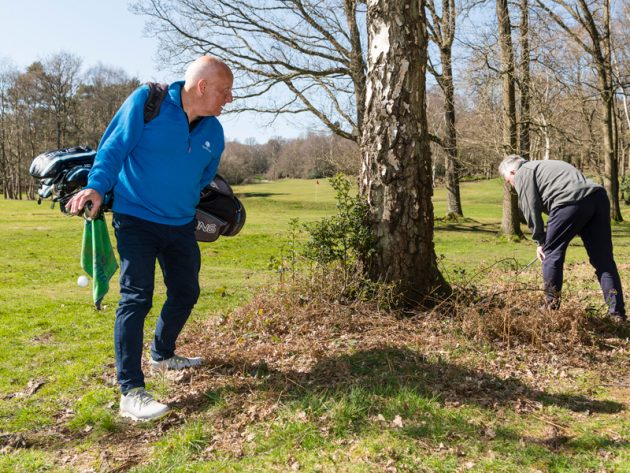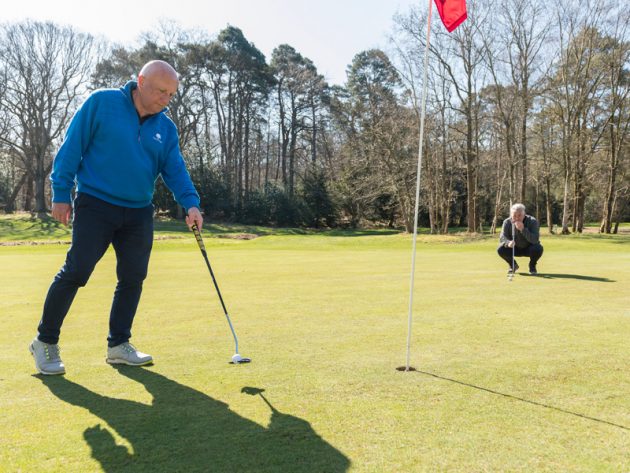Cheating: The Elephant In Golf's Locker Room
Cheating is taboo in this game of absolute integrity, but it happens nonetheless. How prevalent is it and what should you look out for?


Cheating is taboo in this game of absolute integrity, but it happens nonetheless. How prevalent is it and what should you look out for?
Cheating: The Elephant In Golf's Locker Room
In the first round of the 1925 US Open, Bobby Jones was preparing to hit from the rough when he felt his club move the ball slightly. Although nobody had seen anything untoward, he called a penalty on himself. Praised for his sportsmanship after the round, he replied, “You might as well praise me for not robbing a bank.”
This story encapsulates the absolute importance of integrity in golf. Knowingly breaking the rules, or keeping quiet about rules infractions, is simply not acceptable in this sport.
Ours is such an expansive and largely unmonitored game that it falls upon individuals to be utterly honest with themselves and thereby their fellow golfers in order to retain a level playing field on which we all compete, in line with the same rules, in the same spirit.
But, as in pretty much every facet of human life, there will be those prepared to bend or break the rules to gain an advantage. There are always suggestions of cheating throughout the game, from the elite right down to the grassroots level.
The fact that, in the main, these are just suggestions indicates that instances of cheating are really quite uncommon. Most of us have heard stories, but how prevalent is it really?
Subscribe to the Golf Monthly newsletter to stay up to date with all the latest tour news, equipment news, reviews, head-to-heads and buyer’s guides from our team of experienced experts.

Over the years, in amateur and professional golf, only a very few cases of ‘cheating’ have been taken to their ultimate conclusion, resulting in significant action being taken. With 60 million golfers around the planet and only a handful of convicted ‘cheaters’ in the history of the game, we could surely say that cheating was pretty rare.
But how many cases go unreported? With integrity sitting at the heart of golf, an accusation of cheating could be ruinous for an individual, even if proven to be false. It could not only affect their position within the game, but it could also be harmful to their professional and personal life.
For this reason, calling an individual up on a rules infraction is extremely challenging and emotive. To do so there must be absolute certainty of foul play.
In most instances of suspected ‘cheating’ at an amateur level, there will likely be efforts made to afford the individual an opportunity to defend themselves before more public accusations are made.
If a friend or acquaintance appears to do something untoward, one might feel able to challenge them and question their actions. Perhaps they have misunderstood a rule, or perhaps they’ve just had a moment of madness that a quiet word would prevent from happening again.
If not a friend or acquaintance, then maybe a word with someone who is might be appropriate. Information could be discreetly passed on and that might be the end of the matter.

If, however, suspicions are raised on more than one occasion, it then may become appropriate to consider stronger action. But to do this, more than just anecdotal evidence would be required – one person’s word against another’s on a subject this prickly won’t cut it.
Most people would not feel comfortable, or able, to make an accusation of cheating without some sort of proof or multiple witnesses. That level of evidence may be difficult to come by, meaning many incidences of casual cheating are simply left to slide by.
To a certain extent, there must be an element of ‘no smoke without fire’ when it comes to cheating in golf. Suspicions and stories exist – things glimpsed out of the corner of an eye or from a clubhouse window. If someone is spotted doing something dodgy, how likely is it that it’s the only time they’ve erred?
And are there degrees of cheating? With so many rules in golf and so many opportunities to break them, there is perhaps an argument that there’s a sliding scale; that there are some instances of rule breaking that are worse than others. Is dropping a ball down the trouser leg worse than pushing down grass behind the ball in the rough?
Golf Monthly’s view is that cheating is cheating, and any example of wilful rule breaking should be viewed as unacceptable on the same level. Improving a lie is cheating, calling a five when a six was made is cheating, knowingly using an illegal club is cheating, manipulating your handicap is cheating and doctoring a scorecard is cheating.
The only example of a lesser crime is when ignorance is involved. All golfers have a duty to understand the rules, but there are instances when a genuine misunderstanding may lead to an unintentional breaking of the rules. Perhaps a player asks another what club they have just hit, unaware the rules don’t allow that, or they take an incorrect drop without fully understanding the rule or method that should have been applied.

The problem is that incidents seemingly involving ignorance are far easier to challenge and deal with. Spotting someone taking a bad drop, most would feel happy to point out the error and ‘educate’ the player for next time. It’s quite different to accusing someone of blatant cheating. The fact that doing this presents such a minefield, opening accuser as well as accused to scrutiny, means it’s likely that many cheats throughout the game consistently get away with it unchallenged.
With anecdotal evidence at every level of the game, such broad scope for infractions and a reliance on self-policing that a minority choose to be a little lax on, cheating is, unfortunately, something that exists in golf. Most cases go unreported; others are dealt with privately and quietly.
What golf must do is continue to cherish the importance of integrity at the very core of the sport. It must educate newcomers to the game that to be a proper golfer, at whatever level you play, you must be honest with yourself and those you play with and against.
As golfers, all we can do is make sure we follow that guiding principle and be prepared to speak up when we see a fellow golfer breaking or stretching the rules. A polite and quiet word might be all it takes.
With that in mind, here are Golf Monthly’s top-ten areas where golfing cheats look to ‘get away with it’. Keep your eyes peeled...
On-course antics
- Not announcing an air shot: “It was a practice swing!”
- Not announcing a ball moving in the rough: “I got no advantage!”
- Playing from out of bounds: “No, it was just still in... sorry for playing out of turn by the way.”
- Not counting how many shots played: “I think it was a nine.”
- Being late to the tee and not applying the penalty – thought of by many as not cheating but it’s against the rules!
The ‘lost’ ball
- Dropping a ball and playing it – the classic ‘trouser leg’.
- Playing a ball that isn’t theirs: “Yup, found it!”
- Searching for more than three minutes, finding it and then playing on.
- Hitting the same model and number of provisional: “Yeah, this is definitely the first one.”
- Not indicating that the second ball you hit, fearing the first may be lost, is a provisional and then finding the first and playing it. Perhaps this is one that could be due to a lack of knowledge, but it’s still against the rules.
“I’m not playing it from there”
- Kicking it out sideways – the ‘leather wedge’.
- Moving the ball to a preferable spot: “I was just identifying it.”
- Flattening the grass – the pummel, not the waggle, and a downward press!
- Breaking branches: “If I just bend that... SNAP... Ah, there we go.”
- Accidentally knocking off a branch on a practice swing and not declaring it. Also one that some might need a bit of education on.
- Grounding the club in a bunker to improve the route to the ball.

Equipment violations
- Knowingly playing with illegal, non-conforming equipment.
- Altering equipment during a round. This could possibly be ignorance of the rules.
- More than 14 clubs in the bag. Wilful if done knowingly or opportunistic if noticed after the round and not announced.
- Tampering with equipment: Vaseline on clubface for example.
On the green
- Moving the ball marker closer to the hole when a playing partner isn’t looking.
- Marking to the side then re-marking behind – often an indicator of the dishonest golfer.
- Moving a marker off a playing partner’s line and then returning it closer to the hole... a tough one to spot!

Questionable dropping
- Ignoring nearest point of relief.
- Dropping the ball outside the permitted distance.
- Taking liberties with a back-in-line drop: “Yes, this nice clear area is definitely in line with the pin.” Is it really?
- Over-estimating where a ball crossed a penalty area line. Possibly wilful but hard to prove; perhaps a lack of rules knowledge or just a misjudgment.
- Bending the rules to try to get a free drop. Saying you’re going to play a 4-iron when actually you’d only get a wedge at it.
Match play – cheating or gamesmanship?
- Finding an opponent’s ball and not saying anything.
- Not looking for an opponent’s ball. Cheating or bad sportsmanship?
- Deliberate slow play.
- Deliberately putting off an opponent by coughing, rustling change or similar.
Banditry – yes, this is cheating too
- Throwing in high scores to keep the handicap up.
- Not playing enough counting rounds to get cut.
- Throwing in a couple of closing double-bogeys to avoid a handicap cut.
- Declaring a false handicap.

Scorecard shenanigans
- The magic pencil after a round. Wilful doctoring of the scorecard once finished.
- Announcing the wrong score on course. This should be easily challenged by any vigilant playing partner.
- Accepting a lower score written down by a partner. “Erm, yes, that was par.”
- Realising later the score that was inputted was lower but not informing the secretary. “Well I didn’t win anyway.”
- Not handing in the scorecard immediately after a round. This is generally a rules misunderstanding but one that should be pointed out!
Don't forget to follow Golf Monthly on Facebook, Twitter and Instagram.

Fergus is Golf Monthly's resident expert on the history of the game and has written extensively on that subject. He has also worked with Golf Monthly to produce a podcast series. Called 18 Majors: The Golf History Show it offers new and in-depth perspectives on some of the most important moments in golf's long history. You can find all the details about it here.
He is a golf obsessive and 1-handicapper. Growing up in the North East of Scotland, golf runs through his veins and his passion for the sport was bolstered during his time at St Andrews university studying history. He went on to earn a post graduate diploma from the London School of Journalism. Fergus has worked for Golf Monthly since 2004 and has written two books on the game; "Great Golf Debates" together with Jezz Ellwood of Golf Monthly and the history section of "The Ultimate Golf Book" together with Neil Tappin , also of Golf Monthly.
Fergus once shanked a ball from just over Granny Clark's Wynd on the 18th of the Old Course that struck the St Andrews Golf Club and rebounded into the Valley of Sin, from where he saved par. Who says there's no golfing god?